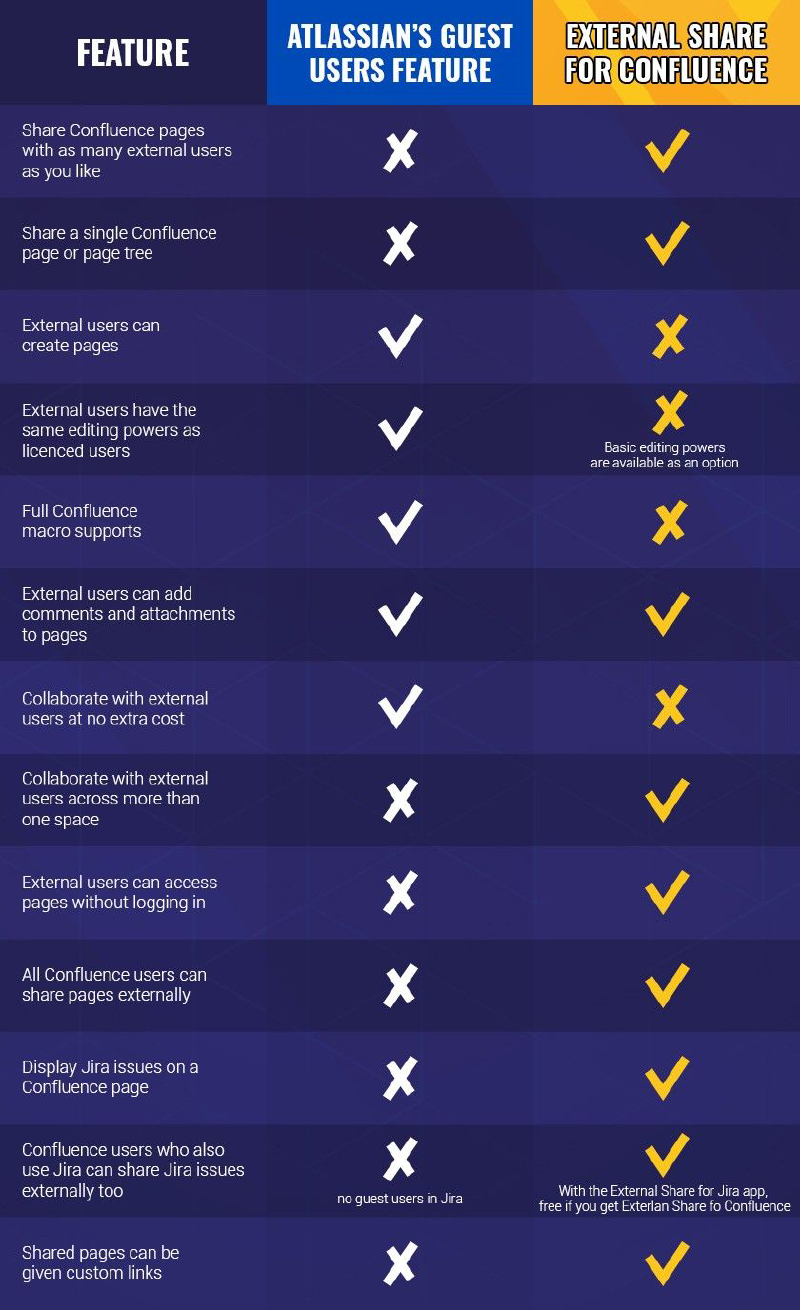External Share for Confluence versus Atlassian's Guest Users Feature

Atlassian recently announced their Confluence guest users feature and people have since been asking us: what’s the difference between the built-in feature and our app, External Share for Confluence ?
Before we go into detail, here’s a handy comparison table, showing the differences in a nutshell.

Now, let’s dive into the details…
What is Atlassian’s Confluence guest users feature?
With this new feature, you can have 5 free guest users per licensed user added to a specific space in your Confluence instance. These guest users become like internal, licensed users, except they only have access to one space. They will be able to create pages, edit pages, and add comments and attachments within that space.
What is External Share for Confluence?
External Share for Confluence is an established Atlassian Marketplace app that allows you to create secure links to specific Confluence pages, page trees, or spaces . You can then share those links with any number of unlicensed users without limit. Unlike the guest users feature, you’re not adding unlicensed users to your Confluence instance.
What is the difference for the external, unlicensed user?
With the in-built guest users feature, the external, unlicensed user becomes like a licensed user, apart from having access to only one space, i.e. they can do almost everything a licensed user can (unless otherwise restricted at the user level by a Confluence space admin) and have the same view/edit experience.
With External Share for Confluence, the external user sees a stripped-back version of the Confluence page, page tree, or space. They will be able to see most macros but not all. They can also edit text and view/add comments and attachments, but not create their own pages.
Which is better for external collaboration?
It depends on the nature of the collaboration…
Ongoing or permanent collaborations
If you’re collaborating with someone on an ongoing or permanent basis, you might want to add the external user to the space as a guest user using Atlassian’s built-in feature.
One-off, temporary, or urgent collaborations
Atlassian’s guest users feature won’t be appropriate if you want a contractor, partner, or customer to review a single Confluence page or page tree, but not the rest of the space. In those circumstances, you would need to share the relevant page/s with them using External Share for Confluence. External Share is also more appropriate for handing over pieces of content for urgent review because you can do so in a few clicks. Adding users to your instance takes more time, effort, and forethought.
Equally, if you’re working with the contractor on a temporary basis, using External Share will protect you from forgetting to remove the users from your instance once the project is over. Also, most Confluence admins hate dealing with access-related things, including adding or removing people. So you’re saving them a headache as well.
Collaboration across more than one Confluence space
There may be times when there is information or content in more than one space that you need your external collaborator to look at. In this case, you’d want to grant the user access to all the relevant spaces. With Atlassian’s guest users feature, you can only add a guest user to one space at a time. With External Share for Confluence, you can create and share links to as many spaces as you like.
On-page collaboration
Atlassian’s guest users feature provides the external user with the same editing powers as any licensed user. External Share for Confluence offers more limited editing powers, i.e. the power to change text but not macros. This makes Atlassian’s guest users feature better for deeper on-page collaborations. However, all guest users have editing powers by default, whereas with External Share, they’re optional. This makes External Share more appropriate if you simply want an external user, e.g. a customer, to review but not change a piece of content, because you can enable them to add comments whilst leaving the editing powers box unticked.
All Confluence macros are available to guest users with Atlassian’s guest users feature, whereas External Share for Confluence supports most macros but not all. External Share does, however, support some Jira macros, whereas Atlassian’s guest users feature does not.
Collaboration with Jira users
External Share for Confluence offers deeper connections with Jira than Atlassian’s guest users feature. The app supports a number of Jira macros, allowing external users to see Jira data on shared Confluence pages. As there are no guest users in Jira (nor any plan to introduce them), Confluence guest users will not be able to access or view any Jira macros.
In addition, External Share for Confluence has a sister app, External Share for Jira, which allows you to share live Jira issues and whole agile boards with external users. External Jira users are able to add comments and attachments to issues, and transition issues between statuses. This means that if you work in Jira and Confluence and you want to assign tasks to anyone not on your instance by way of a Jira issue, you can. Also, when you buy External Share for Confluence, we offer External Share for Jira for free (and vice versa).
Who can use Atlassian’s guest users feature?
Only Confluence admins can add guest users to a space. Likewise, only admins can remove them.
Who can use External Share for Confluence?
All Confluence users can create External Share links to their pages and share them with whoever they wish. Individual users also control how much access their external collaborators have, i.e. whether they can view or add comments. (You do have the option of restricting which internal users can create links, and of monitoring what links are being created.)
Which is more efficient?
It’s very quick and easy for any user to create a link to a Confluence page, page tree, or Confluence space with External Share. Granular control over what your external users can do (i.e. whether they can view or add comments/attachments, and see or not see child pages) is a tick-box affair. It’s also easy for external users to access the pages; they simply click on the link. (You can, however, make it so that only selected external users are able to access your links, in which case they will need an External Share account and be required to log in.)
With Atlassian’s guest users feature, Confluence admins need to add those users to the space, specify their permissions, and remember to remove them again when they no longer need access. It’s a big extra job for the admins that has the potential to become quite regular. Guest users themselves will need to log in in order to access pages, which takes longer than simply opening a link with External Share.
Which is better for security?
The security is different, although it’s fair to say that External Share offers more security *options *than Atlassian’s guest users feature. For instance, guest users have to be added to your instance, and will then always be required to be logged in. With External Share for Confluence, you can add expiration dates and passwords to your shared links if you want to. You also have the option of listing specific external users with which links can be shared, so that links cannot be shared with just anyone. This feature requires those users to have an External Share account before they can access your links.
As mentioned, Atlassian’s guest users feature makes external users just like licensed ones, so they’ll be able to access and do anything an internal one can within the confines of a single space.
Which is more restrictive?
You can only add 5 guest users per paid user to a Confluence space with Atlassian’s guest users feature. With External Share for Confluence, you can send links to as many pages and spaces as you like, and to as many users as you like. And each of those links can have their own expiry dates and permission settings.
Guest users also contribute towards the total Confluence site user limit; total paid and guest users cannot exceed 35K. This could be a problem for big businesses seeking to work with large numbers of external contractors and partners without having to fork out for extra licenses. For those businesses, External Share for Confluence – which does not come with any such limits – would be a better fit.
One huge benefit of External Share for Confluence: custom links and domains
Another big advantage of using External Share for Confluence is custom links. Specifically, you can make all links – to pages, page trees, and whole spaces – come from your website by configuring a custom domain. You can also fully customize each link by removing the default 16-digit code and changing the URL to something more relevant and memorable.
What this means is that you can create an entire knowledge base that’s fully branded to your company with External Share, offering continuity of service to customers and partners.
The guest users feature does not involve creating links, therefore this is no option (nor will there ever be) for using this feature to create custom domains for Confluence.
Find out more about how External Share facilitates custom domains for Confluence and solves a *very *long-running and infamous Atlassian problem.
TL;DR
The long and the short of all this is that both External Share for Confluence and Atlassian’s guest users feature have value for different types of collaborations.
- If you want to have a contractor, partner, or customer working in a whole space on an ongoing or permanent basis, it makes sense to add them as a guest user using Atlassian’s guest users feature. But if it’s a one-off or temporary collaboration and you only want to share the odd page, you’d need External Share for Confluence.
- Atlassian’s guest users feature makes the external user just like an internal one, able to edit content on Confluence pages. You may not want your external user to have editing powers, particularly if you’re just asking a customer to review something, in which External Share for Confluence would be a better fit.
- Atlassian’s guest users feature comes with restrictions that External Share doesn’t. External Share also offers more sharing and security options; is a lot quicker to use and maintain; and comes with the added benefit of being able to set up custom domains and links for your Confluence spaces and pages.






